No CrossRef data available.
Article contents
Mapping Acute Care Systems’ Surge Capacity and Response Priorities – the ‘7S’ Framework Tool
Published online by Cambridge University Press: 22 November 2022
Abstract
During health emergencies, significant disruptions occur concurrently within critical components of acute care systems such as workforce, medical supplies, clinical workflows, patient care pathways, and hospital essential support services. The ability to map both existing and surge capacities across the acute care health system is a complex, nuanced, and often lengthy process which is heavily dependent upon localized knowledge applied in specific, individual contexts.
Outline an innovative, “All Hazards” tool developed through a standardized framework approach to rapidly and consistently identify, assess, and prioritize key system-wide health capacity indicators in acute care hospital settings during health emergencies.
Initially designed as a health systems preparedness and planning tool for use in sudden-onset disasters in 2017, the “7S” framework has been successfully applied during recent AUSMAT outbreak emergency responses to assist local Ministries of Health to effectively identify, articulate, rationalize, and prioritize clinical and operational health response priorities.
Multiple operational health leaders found the “7S” framework valuable in efficiently managing both the assessment of and priority allocation of resources in health systems under duress. The tool was simple to understand and explain, time efficient, and comprehensive. Additionally, the tool provided an effective structure for communicating with local health and response leaders.
The “7S” framework has demonstrated excellent utility as a highly effective and scalable, locally adapted “All Hazards” tool for use during health planning, preparedness, and acute care response phases in diverse health emergencies contexts.

- Type
- Meeting Abstracts
- Information
- Copyright
- © The Author(s), 2022. Published by Cambridge University Press on behalf of World Association for Disaster and Emergency Medicine





